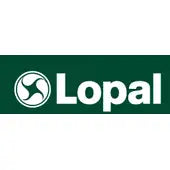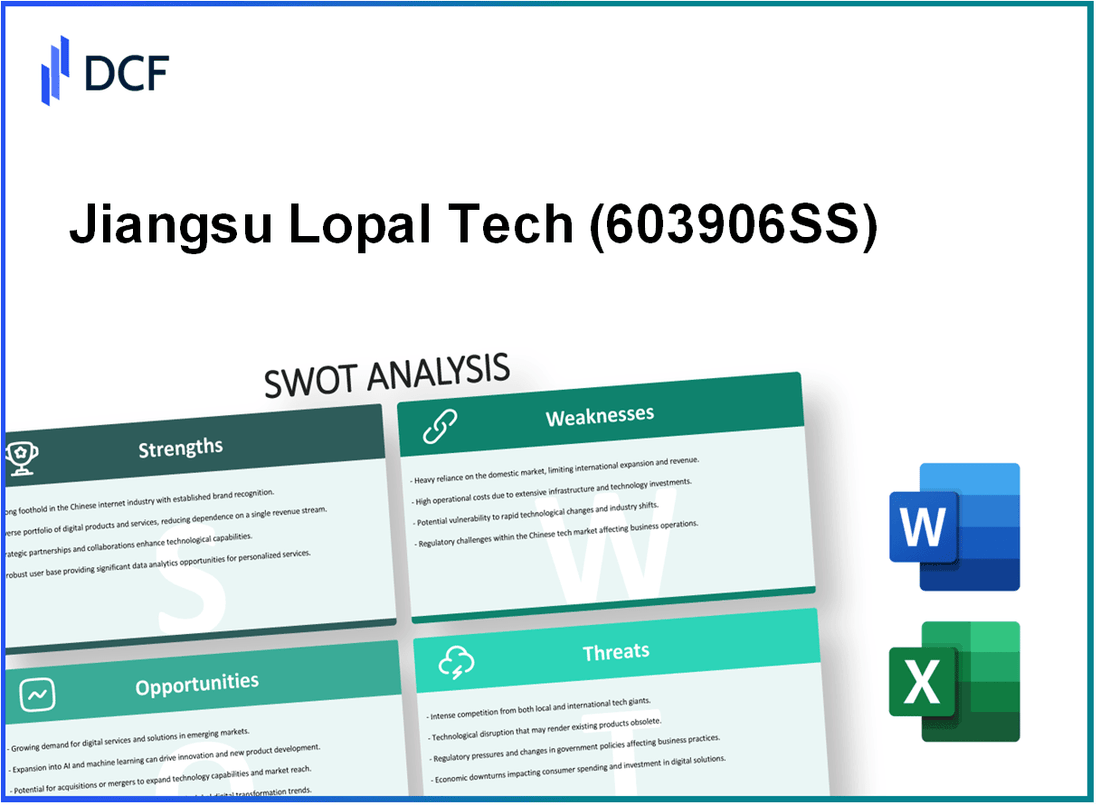
|
Jiangsu Lopal Tech. Co., Ltd. (603906.SS): SWOT Analysis |

Fully Editable: Tailor To Your Needs In Excel Or Sheets
Professional Design: Trusted, Industry-Standard Templates
Investor-Approved Valuation Models
MAC/PC Compatible, Fully Unlocked
No Expertise Is Needed; Easy To Follow
Jiangsu Lopal Tech. Co., Ltd. (603906.SS) Bundle
In the dynamic world of the lubricant industry, Jiangsu Lopal Tech. Co., Ltd. stands out with a rich history and a promising future. But how does it truly measure up against its competitors? This SWOT analysis delves into the strengths, weaknesses, opportunities, and threats facing Lopal, offering insights that could shape its strategic direction and competitive edge. Discover the critical factors that define this company's market position and its potential for growth below.
Jiangsu Lopal Tech. Co., Ltd. - SWOT Analysis: Strengths
Established brand reputation in the lubricant industry: Jiangsu Lopal Tech has cultivated a strong brand presence since its founding in 2000. The company has a significant market share in China’s lubricant industry, which is valued at approximately RMB 140 billion as of 2022. Lopal's brand recognition is evident, with its products being distributed to over 50 countries, solidifying its reputation for quality and reliability.
Strong research and development capabilities: Jiangsu Lopal Tech invests heavily in innovation, with R&D expenditures amounting to about 5% of total sales annually. As of 2023, the company has held over 100 patents related to lubricant formulations and technologies. The R&D team consists of over 200 professionals, focusing on developing eco-friendly products that comply with international standards, enhancing the company’s competitive edge.
Robust distribution network across China and international markets: The company has established a wide-ranging distribution network, comprising approximately 3,000 distributors domestically in China. This network allows Lopal to achieve a quick turnaround in product availability. Internationally, Lopal has partnerships with significant distributors in regions such as Southeast Asia, North America, and Europe, contributing to their international sales, which accounted for over 30% of total revenue in 2022.
| Year | Total Sales (RMB) | International Sales (%) | R&D Investment (RMB) | Patents Held | Distributors |
|---|---|---|---|---|---|
| 2020 | 1,500 million | 25% | 75 million | 85 | 2,500 |
| 2021 | 1,700 million | 28% | 85 million | 90 | 2,800 |
| 2022 | 2,000 million | 30% | 100 million | 100 | 3,000 |
Diverse product portfolio catering to various automotive and industrial needs: Jiangsu Lopal Tech offers a wide range of lubricant products, including engine oils, industrial oils, and specialty lubricants, totaling over 200 different products. This diversity allows the company to cater to multiple segments, from passenger vehicles to heavy machinery. The automotive lubricant segment represents about 60% of total sales, while industrial lubricants account for around 25%, reflecting Lopal's ability to meet different market demands.
As of 2023, the global automotive lubricant market is projected to reach USD 62 billion, indicating Lopal's strategic positioning to capitalize on growth opportunities in this sector. The company is recognized for its commitment to high-quality products, evidenced by numerous certifications such as ISO 9001 and API standards.
Jiangsu Lopal Tech. Co., Ltd. - SWOT Analysis: Weaknesses
Jiangsu Lopal Tech. Co., Ltd. demonstrates several weaknesses that could affect its competitiveness and overall performance in the market.
High Dependency on Domestic Market for Revenue Generation
Approximately 90% of Jiangsu Lopal's revenue is generated from the domestic market. This heavy reliance on the Chinese market exposes the company to risks associated with local economic fluctuations and regulatory changes.
Limited Presence in Emerging Markets Compared to Competitors
As of the latest reports, Jiangsu Lopal has a mere 5% market share in Southeast Asia, while competitors like Sinopec and BASF hold shares of 15% and 12%, respectively. This lack of diversification in emerging markets limits growth opportunities.
Potential Vulnerabilities in Supply Chain Management
The company has reported that 20% of its suppliers are concentrated in a single region in China. This concentration poses a significant risk of disruptions due to regional environmental policies or other local issues.
High Operational Costs Impacting Profit Margins
Jiangsu Lopal's operational expenses stand at roughly 40% of its total revenue, which is significantly higher than the industry average of 30%. This discrepancy in operational costs has resulted in profit margins declining to about 10%, compared to the average industry profit margin of 15%.
| Category | Jiangsu Lopal Tech. Co., Ltd. | Industry Average |
|---|---|---|
| Revenue Dependency (Domestic) | 90% | N/A |
| Market Share in Southeast Asia | 5% | Sinopec: 15%, BASF: 12% |
| Supplier Concentration | 20% | N/A |
| Operational Expenses (% of Revenue) | 40% | 30% |
| Profit Margin | 10% | 15% |
Jiangsu Lopal Tech. Co., Ltd. - SWOT Analysis: Opportunities
Jiangsu Lopal Tech. Co., Ltd. is positioned well to capitalize on several emerging opportunities in its industry. These opportunities can drive growth and enhance its competitive edge in the market.
Growing Demand for Sustainable and Eco-Friendly Lubricants
The global eco-friendly lubricant market is projected to reach $24.5 billion by 2027, growing at a CAGR of 5.2% from $18.5 billion in 2020. This trend is fueled by increased environmental regulations and consumer awareness about sustainability.
Expansion into Untapped International Markets
Jiangsu Lopal Tech has potential in emerging markets, particularly in Africa and Latin America. These regions are experiencing accelerated industrial growth, with forecasts indicating a CAGR of 6.1% in industrial production. In 2021, lubricant consumption in Latin America was estimated at 0.5 million metric tons, with significant room for growth.
Strategic Partnerships and Collaborations for Technological Advancements
Partnerships in R&D can enhance product offerings. For instance, Lopal's collaboration with universities and research institutions can enable the development of innovative formulation techniques. The global lubricants market is projected to be worth $150 billion by 2026, with technology-driven companies expected to capture a larger market share.
Increasing Automotive and Industrial Activities in Asia-Pacific Region
The Asia-Pacific region is witnessing significant growth in both the automotive and industrial sectors. The automotive industry in Asia-Pacific is projected to grow at a CAGR of 7.2% from 2021 to 2028. In 2020, the region accounted for approximately 52% of global lubricant demand, driven by rapid urbanization and industrialization.
| Opportunity | Market Size (2027) | CAGR (%) | Notes |
|---|---|---|---|
| Sustainable and Eco-Friendly Lubricants | $24.5 billion | 5.2% | Growing regulations and consumer awareness. |
| Emerging Markets | 0.5 million metric tons (Latin America, 2021) | 6.1% | Significant industrial growth potential. |
| Technology-Driven Partnerships | $150 billion (Global Lubricants Market, 2026) | Market share driven by innovation. | Collaborations with universities enhance R&D. |
| Automotive and Industrial Growth in Asia-Pacific | 52% of global lubricant demand | 7.2% | Urbanization and industrialization driving demand. |
Jiangsu Lopal Tech. Co., Ltd. - SWOT Analysis: Threats
Jiangsu Lopal Tech. Co., Ltd. faces several threats that could impact its business operations and market position.
Intense competition from global lubricant brands
The lubricant market is characterized by fierce competition, with major players such as ExxonMobil, Shell, and Total dominating the industry. In 2022, the global lubricants market was valued at approximately $151.9 billion and is projected to reach $197.7 billion by 2027, growing at a CAGR of 5.5%. Jiangsu Lopal must compete against these well-established brands, which have significant resources for marketing, research, and development.
Fluctuations in raw material prices affecting production costs
The volatility of crude oil prices directly influences raw material costs for lubricant production. For instance, the average price of Brent crude oil fluctuated between $40 and $100 per barrel in 2022. This variability can lead to increased production costs for Jiangsu Lopal, potentially squeezing profit margins. The rising cost of base oils has also seen an increase of approximately 25% since early 2021, impacting overall production expenses.
Stringent environmental regulations impacting manufacturing processes
Environmental regulations governing the manufacturing processes in the chemical industry are becoming more stringent globally. Regulations in the European Union, for example, impose targets for reducing greenhouse gas emissions by 55% by 2030 compared to 1990 levels. Jiangsu Lopal may incur higher compliance costs due to the need for cleaner technologies and processes, which could impact its profitability and operational efficiency.
Economic slowdown potentially reducing industrial lubricant demand
The global economy's fluctuations can significantly impact lubricant demand. In 2023, the International Monetary Fund (IMF) projected a global GDP growth rate of only 2.9%, down from 3.5% in 2022. A slowdown in industrial activities, particularly in manufacturing and automotive sectors, could result in reduced demand for lubricants, adversely affecting Jiangsu Lopal's revenue streams.
| Threat | Impact | Current Statistic |
|---|---|---|
| Intense Competition | Market share erosion | Market growth from $151.9B to $197.7B by 2027 |
| Raw Material Price Fluctuations | Increased production costs | Brent crude: $40 to $100 per barrel in 2022 |
| Environmental Regulations | Higher compliance costs | EU target: 55% reduction by 2030 |
| Economic Slowdown | Reduced lubricant demand | Projected global GDP growth: 2.9% in 2023 |
Jiangsu Lopal Tech. Co., Ltd. stands at a pivotal juncture, balancing its strong industry reputation and diverse product offerings against market vulnerabilities and competitive pressures. By leveraging emerging opportunities in sustainability and international expansion, the company can navigate threats and enhance its position in the lubricant industry, ensuring sustained growth and profitability.
Disclaimer
All information, articles, and product details provided on this website are for general informational and educational purposes only. We do not claim any ownership over, nor do we intend to infringe upon, any trademarks, copyrights, logos, brand names, or other intellectual property mentioned or depicted on this site. Such intellectual property remains the property of its respective owners, and any references here are made solely for identification or informational purposes, without implying any affiliation, endorsement, or partnership.
We make no representations or warranties, express or implied, regarding the accuracy, completeness, or suitability of any content or products presented. Nothing on this website should be construed as legal, tax, investment, financial, medical, or other professional advice. In addition, no part of this site—including articles or product references—constitutes a solicitation, recommendation, endorsement, advertisement, or offer to buy or sell any securities, franchises, or other financial instruments, particularly in jurisdictions where such activity would be unlawful.
All content is of a general nature and may not address the specific circumstances of any individual or entity. It is not a substitute for professional advice or services. Any actions you take based on the information provided here are strictly at your own risk. You accept full responsibility for any decisions or outcomes arising from your use of this website and agree to release us from any liability in connection with your use of, or reliance upon, the content or products found herein.
